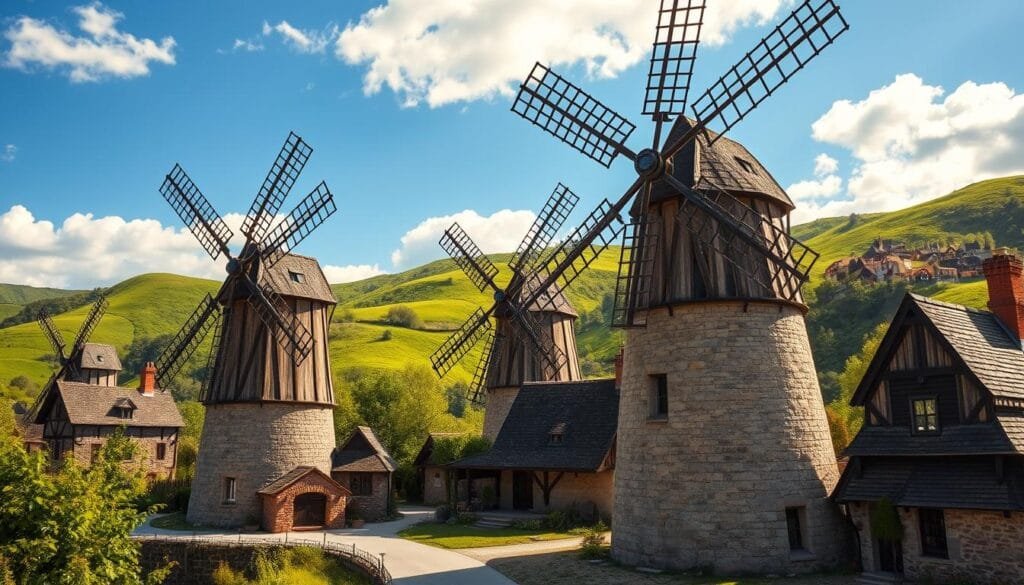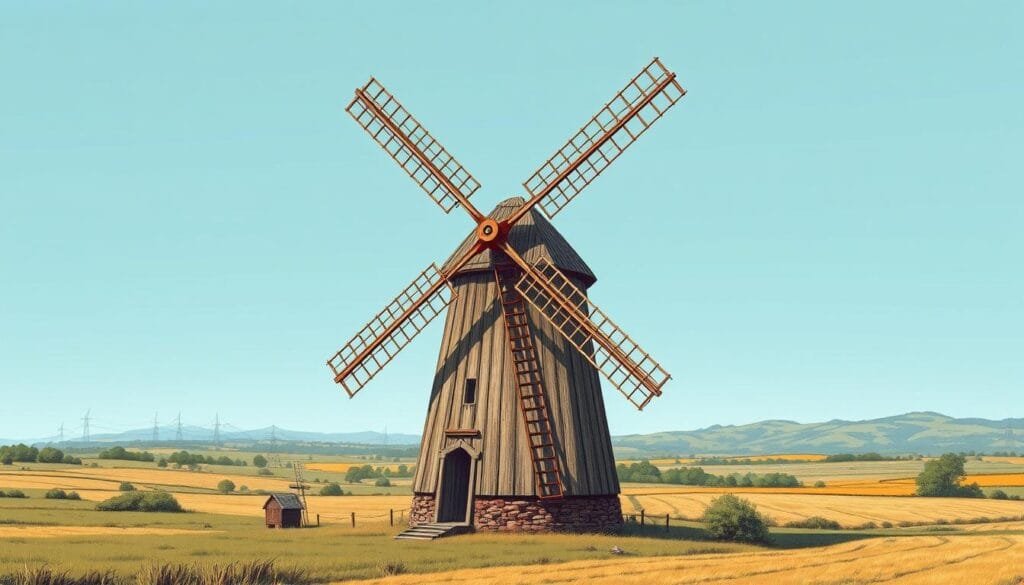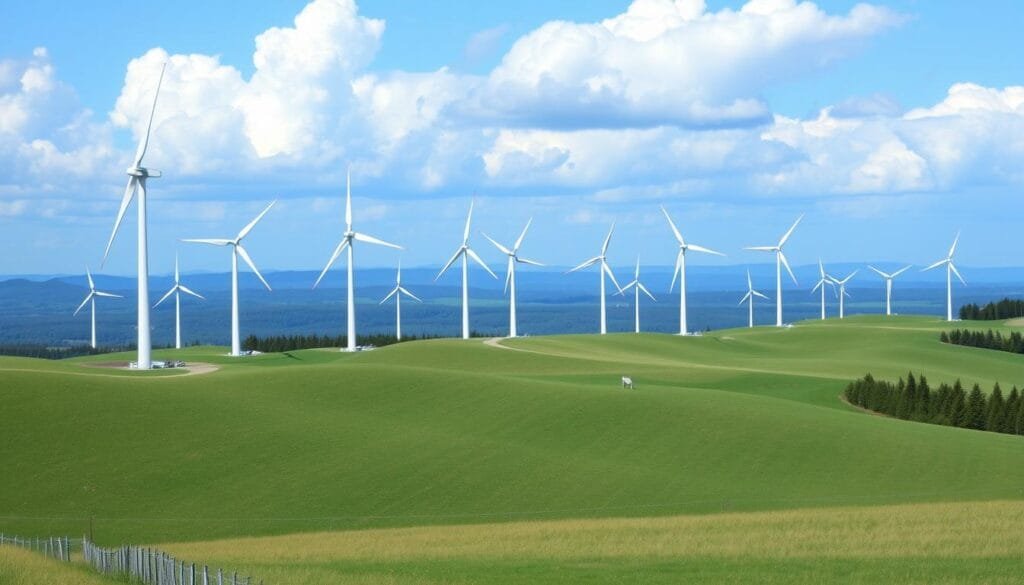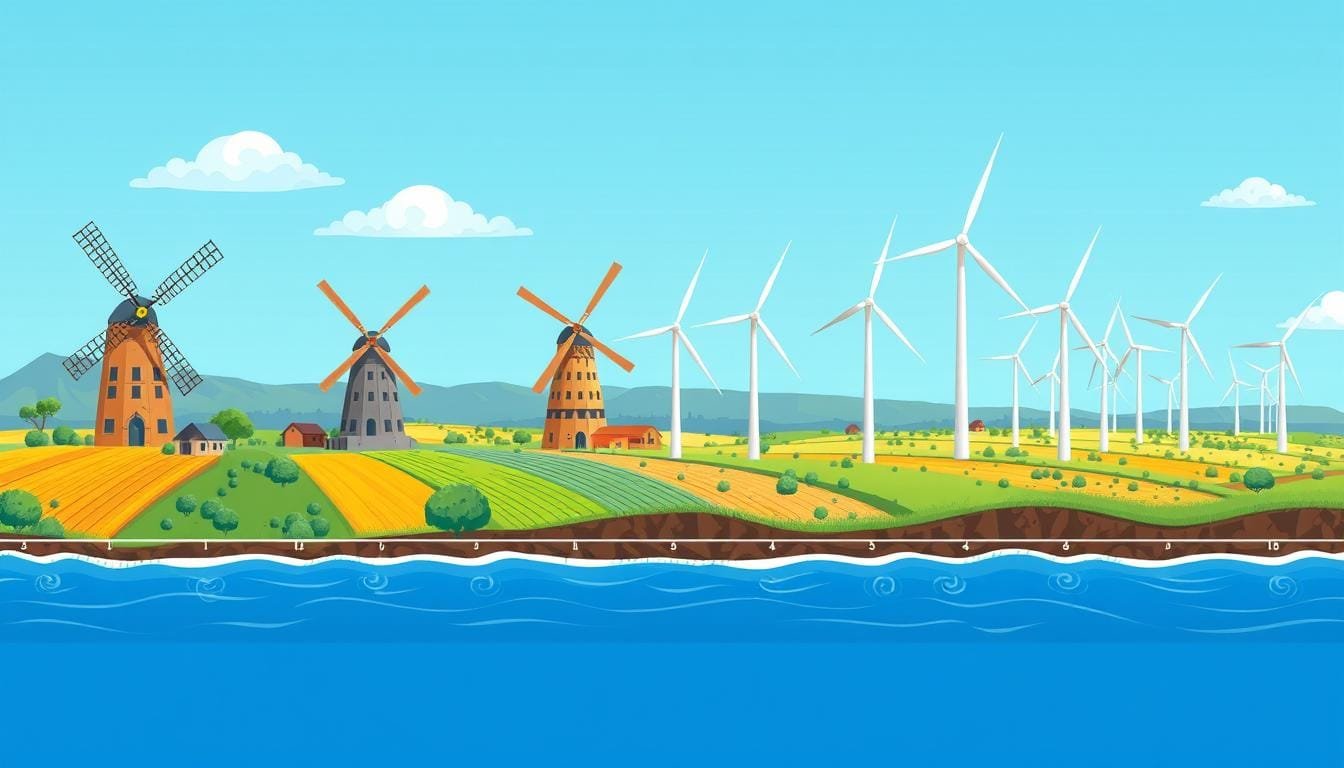Did you know wind energy has powered us for over 5,000 years? It started with ancient Nile boats and now we have huge turbines. This shows how far we’ve come in using wind to make electricity.
The story of who made wind turbines is full of human creativity. Wind power began long ago, but today’s turbines were made by inventors in the late 1800s. They turned wind into a way to make electricity.
Wind turbines have a long history, with ancient people using wind for moving things and grinding grain. In the 9th century, Persians used windmills, and in the 1880s, Scots and Americans made big improvements. Each step helped us understand renewable energy better.
Key Takeaways
- Wind energy has been used for over 5,000 years
- First electricity-generating windmill built in 1887
- Multiple countries contributed to wind turbine development
- Wind power is a key renewable energy source
- Technological advances keep making wind energy better
The Origins of Wind Power: From Ancient Times to Modern Era
Wind energy is a remarkable innovation that dates back to ancient times. It shows how humans have always tried to use natural forces for their benefit. The history of wind turbines is a story of human ingenuity.
For thousands of years, humans have been using wind power. Our ancestors were very smart and saw the value of wind long before we did. They were true renewable energy innovators.
Early Wind Usage in Ancient Civilizations
Many ancient cultures understood and used wind power in amazing ways:
- Egyptian sailors used sail-powered boats around 3,200 BCE
- Proto-Austronesian people sailed the South Pacific with wind power
- Mesopotamian people used wind for their transportation
Maritime Applications in Early History
Wind-powered boats were a big step forward in travel. The first sailing boats were around 6,000 BCE. They showed incredible engineering skills.
Wind energy comes from the sun heating the earth, causing air to move due to temperature differences.
Development of First Windmills
Wind technology evolved in different places:
| Region | Year | Wind Technology Development |
|---|---|---|
| Persia | 644 AD | First recorded windmills using stone mechanisms |
| Hellenistic Greece | 10-70 AD | Early windmill designs by Heron of Alexandria |
| Europe | Late 12th Century | First documented European windmills in France and Belgium |
These early windmills were the start of today’s wind turbine technology. They show our long history with wind energy.
Ancient Innovations: Wind-Powered Vessels and Early Mechanisms
The history of wind turbines goes back to our earliest sea travels. Sailing technology was a big leap forward in human history. It shows that people used wind power for boats and machines over 8,000 years ago.
Old civilizations made amazing wind-powered tech that helped start today’s wind energy. The first time people used wind for real tasks was in Mesopotamia, about 3,700 years ago. This shows how early humans understood wind’s power.
- Sailing vessels from Eastern European cultures like the Cucuteni-Tryptillian used smart ways to catch wind.
- Wind power helped people explore and trade over long distances.
- Early machines turned wind energy into mechanical power for many uses.
*Wind has been a source of human innovation for over a millennium, driving progress across civilizations.*
Using wind power, ancient societies could go beyond their borders. Wind energy was key for things like irrigation and sea travel. These early steps led to more advanced wind-powered tech in later centuries.
| Ancient Civilization | Wind Power Application | Estimated Period |
|---|---|---|
| Mesopotamia | Irrigation Systems | 3,700 years ago |
| Eastern European Cultures | Maritime Transportation | 6th Millennium BCE |
| Middle Eastern Regions | Early Windmill Mechanisms | 7th Century CE |
These early wind energy efforts show that sustainable tech has deep roots in human creativity. They connect our history with today’s green energy solutions.
The Birth of Windmill Technology in Hellenistic Greece
The ancient world saw big steps in wind energy tech. Hellenistic Greece was key in this, showing early designs of wind turbines. This was a big leap in technology.
Greek inventors were drawn to wind power. They worked on complex machines that would inspire many engineers later. Their work showed how to use natural energy.
Heron of Alexandria’s Wind-Powered Organ
Heron of Alexandria, living from 10-70 AD, created something amazing. His wind-powered organ showed how to turn wind into mechanical power. It was a big step in understanding energy.
“Imagination is the source of innovation, and wind represents an unlimited power for mechanical energy.” – Inspired by Heron’s work
- Invented a windwheel-driven musical instrument
- Demonstrated advanced mechanical engineering skills
- Proved wind could power complex machinery
Persian Panemone Windmills
At the same time, Persian engineers were working on windmills. They made horizontal-axis windmills in the ninth century AD. These designs were a big leap forward.
| Region | Design Characteristics | Primary Use |
|---|---|---|
| Persia | Horizontal-axis configuration | Grain milling |
| Mesopotamia | Multiple sail configurations | Water pumping |
These early civilizations showed great creativity. They turned wind’s energy into useful work. This was a big step towards renewable energy.
Medieval European Windmill Revolution

The medieval European windmill revolution changed how people farmed and worked in factories. France and Belgium led the way in wind power in the late 12th century. They created new designs that boosted economic output.
Early European windmills were big steps forward in wind turbine history. They were powerful tools for tasks like grinding grain and pumping water.
“Wind is the breath of industry’s first mechanical heart” – Anonymous Medieval Engineer
- First documented European windmill: 1185 in Yorkshire, England
- Primary windmill types: Post mills, Tower mills, Smock mills
- Key regions of windmill development: Netherlands, France, Germany
The Netherlands was famous for its windmill tech. By 1850, it had 6,000 to 8,000 windmills. This showed how important they were for the economy.
| Region | Windmill Count (Peak Period) | Primary Usage |
|---|---|---|
| Netherlands | 9,000 (1850) | Land drainage, Grain processing |
| United Kingdom | 10,000-12,000 | Agricultural processing |
| Germany | 18,242 (1895) | Industrial applications |
Wind power leaders in this time made windmills more efficient. They changed from simple designs to complex ones. This led to more uses in European industries.
Who Created Wind Turbines: The Pioneer Inventors
The journey of wind turbine technology is filled with remarkable innovators. They changed how we use renewable energy. These inventors started the path to modern sustainable power, pushing tech limits in the late 19th century.
- James Blyth (Scotland)
- Charles Brush (United States)
- Poul la Cour (Denmark)
James Blyth’s Scottish Innovation
In 1887, James Blyth built the first windmill for electricity in Scotland. His work showed wind power’s electrical promise, motivating others to explore wind energy.
Charles Brush’s American Contribution
Charles Brush was a key figure in the U.S. wind turbine scene. In 1888, he set up the first wind turbine in Cleveland, Ohio. It was a 12-kilowatt system, a big step in renewable energy.
Poul la Cour’s Danish Legacy
Danish engineer Poul la Cour greatly helped wind power. By 1900, Denmark had about 2,500 windmills making 30 megawatts of power. La Cour also created a better energy regulator.
“The future of energy lies in harnessing the power of wind” – Early Wind Power Pioneers
These inventors changed our view of wind energy. They paved the way for today’s wind power systems worldwide.
The Halladay Windmill: First Commercial Success

In the mid-19th century, Daniel Halladay and John Burnham changed farming with their windmill. They patented it on August 29, 1854. This windmill was a big step forward in wind technology, changing how water was managed in the American West.
The Halladay Windmill was special for many reasons:
- It had self-furling sails that worked without people
- It could pull water from 28 feet deep
- It could lift water over 100 feet high
- It worked even at wind speeds as low as 11 mph
Affordability was key to the Halladay Windmill’s success. It cost just $50 to start, with another $25 for pumps and pipes. This made it easy for farmers to get a reliable way to manage water. The Halladay Windmill Company, started in 1854, became a key player in Western farming.
“A revolution in water management, one windmill at a time.” – Agricultural Innovation Journal
The windmill’s impact was huge. Thousands were sold to farmers and ranchers, thanks to the railroad and steam engines. By the 1930s, over six million farm windmills were across America, with the Halladay design being a big part of this change.
The work of these inventors did more than just pump water. They showed the power of wind long before today’s wind turbines. Their work was a big step towards renewable energy.
The Evolution of Wind Turbine Design
Wind turbine technology has changed a lot in the last 100 years. It moved from old multi-blade designs to today’s advanced models. This change shows how engineering and green energy have grown together.
From Multiple Blades to Three-Blade Configuration
Old wind turbines had many blades, from 12 to 144. But, a Danish engineer named Johannes Juul changed everything. He created the first three-blade design, which is what we use today.
- Early multi-blade turbines: Complex and less aerodynamic
- Three-blade design: Improved efficiency and power generation
- Reduced mechanical complexity
- Better wind capture and energy conversion
Technical Innovations Through Decades
Wind turbine tech has gotten much better over time. We’ve moved from small generators to huge machines. This change is amazing.
| Era | Technological Milestone | Power Capacity |
|---|---|---|
| 1887 | First Power-Generating Turbine | 10 kW |
| 1931 | First Horizontal-Axis Wind Generator | 100 kW |
| 1956 | Gedser Turbine | 200 kW |
| 2022 | Modern Offshore Turbines | 12 MW |
The history of wind turbine design shows great engineering skills. Now, most turbines are horizontal-axis models. This is a big step forward in green energy.
“The future of energy lies in our ability to innovate and harness natural resources efficiently.” – Renewable Energy Expert
The 1970s Energy Crisis: Catalyst for Modern Wind Power
The 1970s were a turning point for wind turbines. They became key in solving a global energy problem. The OAPEC oil embargo in 1973 made oil prices jump from $3 to $12 per barrel in just months. This change shook the world’s economy.
“The energy crisis was not just an economic challenge, but a catalyst for transformative renewable energy solutions.”
During this time, important things happened:
- Dramatic shifts in energy consumption patterns
- Increased government support for alternative energy research
- Renewed interest in wind power as a sustainable energy source
Renewable energy innovators saw a chance to improve wind turbine technology. The crisis showed the U.S. was too dependent on foreign oil. This led to big changes in laws.
The Emergency Petroleum Allocation Act of 1973 and the Energy Policy and Conservation Act of 1975 showed a new focus on energy independence.
By 1977, the Department of Energy was formed. This marked a new era in energy policy. Wind turbine designs got better fast. Companies like Jacobs Wind made 10kW systems that could power homes.
The energy world changed a lot. Between 1975 and 1985, over 10 U.S. patents were granted for new wind turbine designs. These innovations helped pave the way for future green energy technologies.
NASA’s Role in Wind Turbine Development
NASA made a big leap in wind turbine technology in the 1970s and 1980s. They created key innovations that made wind energy a real power source. This was a big change from just an idea.
In 1975, NASA started a big wind turbine program. They aimed to make wind turbines that could power homes and businesses. They kept making better models to push what was possible.
Pioneering Prototypes and Performance
NASA’s work on wind turbines was a step-by-step journey:
- MOD-0: First 100 kW prototype with 38-meter rotor diameter
- MOD-1: World’s first 2 MW turbine, developed with General Electric
- MOD-2: Turbines with combined 7.5 MW capacity
- WTS-4: 4 MW turbine operational from 1982 to 1994
The Viterna Method: A Technical Breakthrough
In 1981, NASA introduced the Viterna method. This method greatly improved how wind turbines were designed. It made predictions much more accurate, cutting down errors by 50-100%.
“The Viterna model became the most widely used stall model in the United States for wind turbines” – NASA Research Documentation
Collaborative Utility-Scale Programs
NASA worked with big names like General Electric and Boeing. Together, they made wind turbines bigger and better. This helped make wind power a bigger part of our energy mix.
| NASA Wind Turbine Model | Power Rating | Years of Operation |
|---|---|---|
| MOD-0 | 100 kW | 1975-1977 |
| MOD-1 | 2 MW | 1979-1981 |
| WTS-4 | 4 MW | 1982-1994 |
| MOD-5B | 3.2 MW | 1987-1996 |
By 2005, NASA’s work had a lasting effect. The Viterna model was used in design software at the National Wind Technology Center. This showed how far wind turbine technology had come.
Birth of Commercial Wind Farms
The start of commercial wind farms was a big step for those pushing for green energy. In December 1980, a key project in New Hampshire set a new standard. It was the world’s first commercial wind farm.

U.S. Windpower led the way with 20 wind turbines, each making 30 kilowatts. This showed that wind power could be a real energy source.
“The future of energy lies in harnessing the natural power of wind” – Early Wind Energy Visionary
- First commercial wind farm location: New Hampshire
- Number of turbines: 20
- Individual turbine capacity: 30 kilowatts
- Total farm capacity: 600 kilowatts
Early on, wind energy pioneers faced many obstacles. They had to deal with technical issues, money problems, and rules. But they kept going, making wind power a real option for energy.
| Year | Milestone | Significance |
|---|---|---|
| 1980 | First Commercial Wind Farm | Proved commercial viability of wind energy |
| 1991 | First Offshore Wind Farm | Expanded wind energy’s reach |
The New Hampshire wind farm was more than just a project. It showed our ability to create clean energy. It could change how we make power all over the world.
Offshore Wind Power Revolution
The offshore wind power scene is changing fast. It’s pushing the limits of what’s possible in renewable energy and wind turbine tech. Coastal areas are looking for green energy, and offshore wind farms are leading the way.
The Revolution Wind project is a big deal in offshore wind in the U.S. It’s 15 miles off Rhode Island’s coast and 32 miles from Connecticut’s. This project shows how far offshore wind can go.
Innovative Offshore Wind Capabilities
- Total capacity of 704 megawatts
- 65 Siemens Gamesa turbines with 11-megawatt capacity
- Potential to power over 350,000 homes
- Eliminates more than one million metric tons of carbon pollution
Economic and Environmental Impact
This project shows how wind turbine tech has evolved. It’s creating 1,200 direct jobs and thousands more indirectly. It’s also investing over $100 million in port upgrades in Connecticut.
“Revolution Wind represents a critical step towards our clean energy future, bridging technological innovation with environmental sustainability.” – Renewable Energy Expert
The project meets big state goals. Rhode Island wants to be 100% renewable by 2033, and Connecticut aims for zero carbon by 2040. By 2026, Revolution Wind will be up and running, a big win for green energy.
Global Leaders in Wind Energy Production
The world of wind energy has changed a lot. Leaders in sustainable energy are now key players globally. Countries are competing to be at the forefront of wind energy, pushing for new tech and clean energy.
By 2022, wind energy had made huge strides. It has almost tripled from 2015. Now, over 2,304 TWh of electricity is supplied worldwide, making up 7.8% of global power.
| Country | Wind Power Capacity | Key Achievements |
|---|---|---|
| China | Leading global producer | 78.3 TWh annual growth, 33.6% world wind power share |
| United States | 380 billion kWh in 2021 | 10.2% of utility-scale electricity generation |
| Germany | 58 GW capacity | Over 28,440 onshore wind turbines |
| India | 15,000 MW annual manufacturing | Potential of 695.50 GW at 120 meters |
The world of wind energy shows great progress. Thirty-two countries now get more than 10% of their power from wind. This is a big step towards using more sustainable energy.
“Wind energy is no longer an alternative—it’s becoming a primary source of global electricity generation.” – Global Energy Research Institute
- Offshore wind installations represent 10% of new wind power projects
- Global installed wind power capacity exceeded 800 GW in 2021
- Approximately 100 GW was added in that year
Experts say we need to keep growing wind energy. They suggest we should add over 1% of global electricity generation each year to meet climate goals.
Technological Breakthroughs in Modern Wind Power
Wind turbine technology has made huge strides in recent years. This has changed the way we use renewable energy in the United States. Pioneers in green technology have led the way, making wind power more efficient and effective.
- Tower heights increased from 30 to 90 meters
- Rotor diameters expanded from 30 to 125 meters
- Power capacity grew from 0.2 MW to 3 MW
- Capacity factor improved from 22% to nearly 35%
New materials and smart designs have been key in improving wind turbines. Now, blades are made of carbon fiber, making them lighter and stronger. Intelligent controllers adjust blade positions to catch more wind.
The National Renewable Energy Laboratory predicts technology innovations could unlock 80% more economically viable wind energy capacity by 2025.
| Technological Innovation | Impact |
|---|---|
| Smart Grid Integration | Improved energy dispatch and reliability |
| Advanced Energy Storage | Mitigates wind power intermittency |
| Artificial Intelligence | Optimizes turbine performance and maintenance |
New technologies like wake steering and advanced weather forecasting are expanding wind energy’s possibilities. They promise even better and cheaper renewable power.
Conclusion
The history of wind turbines is a story of human innovation and progress. The first electricity-generating wind turbine was built in Scotland in 1887. Today, wind turbines are a key part of renewable energy worldwide.
By 2015, over 314,000 turbines were making about 3.7% of the world’s electricity. This is a big step forward in using renewable energy.
The story of wind turbines is also about teamwork around the world. Pioneers like James Blyth in Scotland and Charles F. Brush in the United States helped a lot. Innovators in Denmark, the Soviet Union, and NASA also played big roles.
They turned wind power into a common energy source. The 1970s energy crisis and NASA’s wind power tests helped a lot. They set the stage for today’s wind energy systems.
Wind energy is key to solving global climate problems. Countries like Denmark and Sweden show how wind power can meet a lot of energy needs. With better technology and more focus on green energy, wind turbines will be even more important.
The story of wind turbines is about human creativity, caring for the planet, and staying strong in the face of challenges. As we keep improving wind power, we’re getting closer to a cleaner energy future for all.

